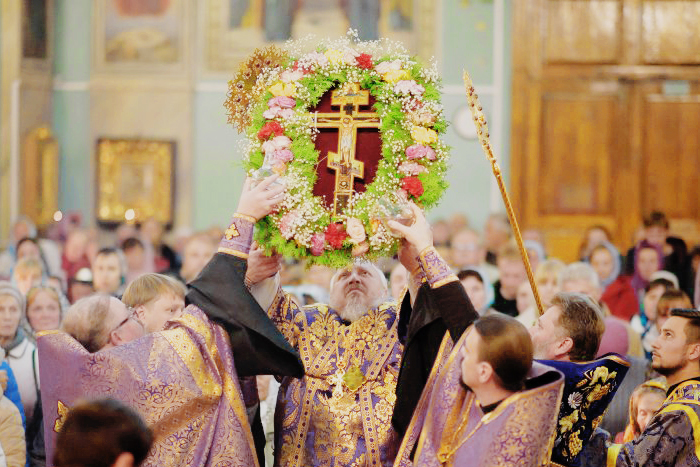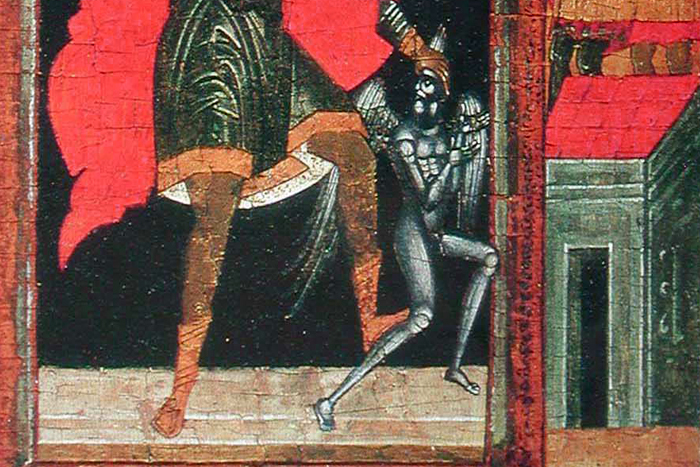
Animals were created before humans: aquatic (reptiles) and airborne (birds) creatures were created on the fifth day of creation, whereas terrestrial creatures were created on the sixth day, and human beings were created shortly afterwards. The animals lived in peace with man and with each other, not knowing any predation. Man was the Crown of God’s Creation, a master over every living being, to whom he had to give names by virtue of the right given to him by the Creator (cf. Genesis 2: 19). It was a world, including the animal world, which did not know decay. All creation was filled with joy, as Saint Maximus the Confessor put it.
Everything changed after the Fall. God said to Adam, who had breached the covenant, [C]ursed is the ground for thy sake (Genesis 3: 17). Therefore, man was responsible for the affliction of the whole cosmos, all creatures, for the desecration of existence as the communion with God. The whole creation groaneth and travaileth in pain together until now (Romans 8: 22). The redemptive sacrifice of Christ opened up the possibility for Man to enter the Heavenly Kingdom, but do animals inherit it as well?
This issue has remained inadequately addressed by Orthodox theology. Although Prophet Isaiah prophesied the future bliss of the animal world, The wolf also shall dwell with the lamb, and the leopard shall lie down with the kid; and the calf and the young lion and the fatling together; and a little child shall lead them. And the cow and the bear shall feed; their young ones shall lie down together: and the lion shall eat straw like the ox. And the sucking child shall play on the hole of the asp, and the weaned child shall put his hand on the cockatrice’ den (Isaiah 11:6-8), opponents’ voices are those that are most often heard in the discussion whether animals inherit the Kingdom of Heaven. The ancient Church did not reach a consensus patrum on this issue (and She hasn’t reached it until now, in fact). There is no systematized and coherent teaching of the Church about animals. Ecumenical Councils did not work out a doctrine concerning animals. There are just a few rulings of the Sixth Council concerning the canonical law (a prohibition to eat together with animals and a prohibition to bring animals to church). As far as the concept of the Animal and its fate is concerned, there is only a number of personal opinions of some Church Fathers.

The issue of whether animals inherit the Kingdom of Heaven is a matter of counterposing animals and humans. There are various arguments to be made here: the animal is not created “in the image and likeness”, its function is only instrumental in relation to man; it serves man while in the Kingdom of Heaven there will be no need for their services.
Additionally, the animal world is a self-contained world, whereas man is the only creature of God who needs the Other, i.e. God, to accomplish his full potential. The animal is unable to perceive the Revelation as it involves a certain “activity, which implies appropriate mental and volitional abilities” (Semyon Frank). “The animal does not know this spiritual thirst. When it is calm, full and satisfied, it is happy. That is not what man is” (the Rev. Aleksander Men). Meanwhile, the Rev. Alexander Men was hoping that the animals’ souls were immortal and would go to heaven, because they knew no treachery or other human vices. St. Luke of Crimea (Voino-Yasenetsky) believed that “the spirit of animals is also tied to the body like ours, and therefore there is every reason to expect that their bodies will exist in the new nature, in the new universe after the death of the present world.”
It is worth noting that the animal does not always act according to its prescribed natural “program” and can also behave abnormally, showing unique characteristics that resemble human virtues. It is capable of loyalty to death; it can feel pity and compassion, guilt and shame.
There are many testimonies of unexpected benevolence and assistance of even the most ferocious animals to the saints in the Orthodox hagiography and in the preserved legends or folklore tales. Ravens brought bread and meat to Prophet Elijah. There is an interesting legend, retold by Cassian, a 5th-century monk, about the Apostle John the Evangelist, who tamed a partridge and often spent his free time playing with that bird. Ancient Patericons inform us that animals often refused to attack Christians in the circus, even though pagan Romans had thought that they would tear Christians apart. For example, an Atlassian lion caressed and licked the feet of Deaconess Tatiana (3rd century) on one of the arenas in Rome. Her guards and persecutors thought that the lion was tame and rushed at the predator fiercely but the beast immediately ripped one of them apart.

St. Mamant lived on a mountain near Caesarea of Cappadocia in the 3rd century. His hut was visited by his ‘friends’ – as the saint himself liked to call them – including deer, goats, hyenas, lions (all at once). St. Anthony the Great (3rd-4th centuries) was met by a hyena, which showed him the way in the Egyptian desert. A raven fed him with bread, and lions were serving him. More recently, in the 14th century, St. Sergius of Radonezh, who committed himself to asceticism in a small cell in the woods, managed to make friends with a wolf and a family of wild boars. He even fed a bear with bread, and he often gave his last loaf to the clubfoot. We read in the biography of St. Herman of Alaska (1756-1836): “Ermines lived near his cell. They are notable for their fearfulness but they would run to St. Herman and eat from his hands. He was seen feeding a bear, too.”
Here’s another example, this time from the life of our contemporary. When St. Kuksha of Odessa was sixty-three years old, he was sent to work in the forest for 14 hours a day during the years of Stalin’s repressions and persecutions against the Church. Poor convicts were almost never fed. Suddenly, a miracle happened to the monk: a raven began to feed him after his daily hard labor.
Why do things like these happen? St. Isaac the Syrian stated, “Animals smell paradise and go to the saints” – and pious people, too, we might add…
“Let every thing that hath breath praise the Lord,” the Psalmist exclaims. Thus, every creature is ontologically included in the fellowship with the Creator. This communion is hierarchical, but Divine Love does not reject any of its creatures. Ironically, it was not man, the Crown of Creation, who was the first to offer hospitality to God, but animals, albeit involuntarily. God was born in a stable next to animals, while the people in Bethlehem had refused to open their doors to the Savior entering the world and hadn’t offered Him shelter.




Romans 8: “Creation will be set free from its slavery to corruption and share in the glorious freedom of the children of God.”
I have always believed that our non-human brothers and sisters are pure innocence. They have no need of baptism or salvation as we humans do. But as we crave to be included in the heavenly eternal vision, so do the non-humans deserve eternal life in that un-created eternal light. Will I see my furry cat companions again? I sure hope so. As I look forward to being with my loved ones, I include the cat people, dog people, horse people, etc. All are children of a most benevolent, loving and merciful Father-Creator.
Thank you for these comments, Dominic Joseph Radanovich. I share your views.
What a delightful post that has meaning and resonance for all of His creation. Thank you Anna.
Interesting premise and good goal but based on poor foundations, if one understands and truly respects the consensus patrum one would approach this differently (Men’, for example, did not understand the consensus).
Wonderful article!
Greetings! If I may ask, who wrote the icon of Saint Gerasimos of the Jordan with a lion? It is quite lovely.
Oleg Shurkus is the author of this icon.
Thank you, Editor. I appreciate your response.